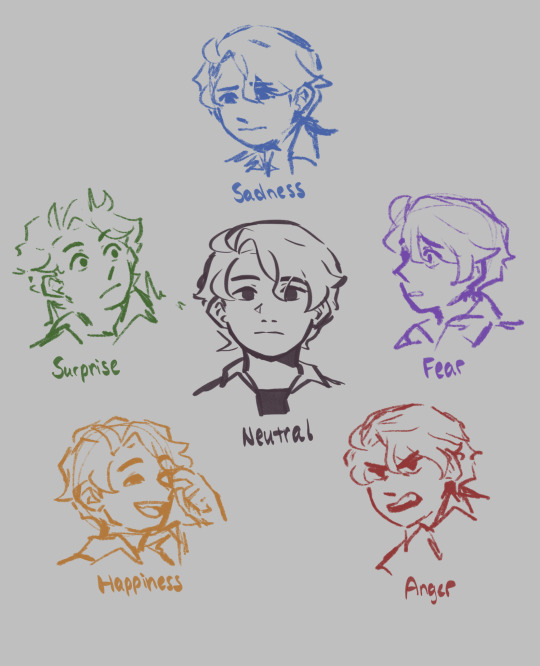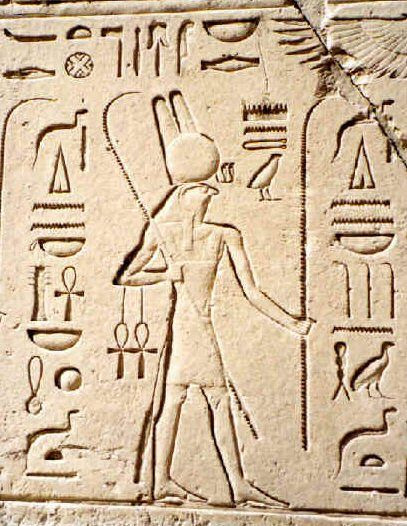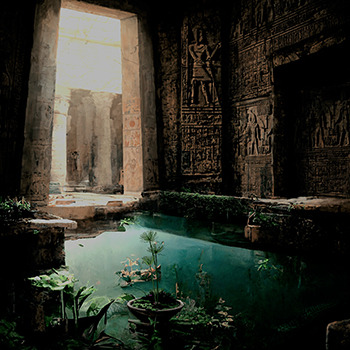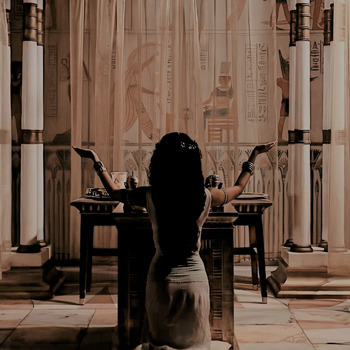#montu god
Explore tagged Tumblr posts
Text

Bast-Mut & Montu ✨
Hello! This is a commission made for @obsydian! 🌟
Thank you very much for your support! I hope you like it!
——————
I do $5USD commissions!
Send a message if you want one :3
Thank you!
#kemetic#egyptian gods#kemetic deities#ancient egypt#kemetism#witchblr#Bast-mut#montu#montu god#bast goddess#mut goddess#bast-mut goddess
33 notes
·
View notes
Text





Some OCs I’m using to practice expressions and lighting for my character design class.
#my art#original character#practice#Kamar counts as an oc right?#even if he started off as Khonshu#from Moon Knight#yeah#he even changed his name and turned human#kamar jakob grant#he is super proud of that name#the yellow eyed guy next to him is Montu#possessed by a god hehe
32 notes
·
View notes
Text
Montu
youtube

Montu es el netkher de la guerra, del alto Egipto y manifestación del sol abrazador, es por esta razón que también lleva el epíteto de Montu-Ra.
Su nombre significa ''Nómada'', es un dios muy antiguo, tras ser reconocido por el epíteto de Montu-Ra fue considerado cómo un netkher de la guerra, uno de sus títulos era ''Horus con el brazo fuerte''.
Tuvo varias consortes, entre ellas se encontraban Tenenet/Tyenenet, netkher de la maternidad, Rattaui/Raet-Taui, señora de las dos tierras y personificación del sol, contraparte femenina de Ra y madre de Harpra y Harpocrates, y Iunyt/Tunit, netkher de la fertilidad y el campo.
El centro del culto de Montu se situaba en Hemonthis (Tierra de Montu), Tebas, Nubia, Medamud, Karnak, lugar donde su templo yace junto al de Amen, Amant y Tod.
Su festividad se celebra el 5to día del mes de la estación de Akhet/Ajet
Fue hijo adoptivo de Amen y Mut, luego sería reemplazado por Khonsu, esto debido a que, según la mitología, Montu se percato que su importancia se vería opacada por la de sus padres, es por esta razón que decidió escapar a Hermonthis.
Los Greco-Romanos le nombraron Month y lo asociaron a Apolo/Sol y Ares/Marte.
Fue sincretizado con Her/Heru, Ra, Ra-Horakhti y Bakh, recibiendo los nombres de:
Montu-Her (Month-Horus)
Montu-Ra (Month-Ra)
Montu-Bakh (Month-Buchis/Month/Bujis)
Montu-Ra-Horakhti (Month-Ra-Horakhti)
Fue en la dinastía XI donde los faraones decidieron portar su nombre, Montuhotep/Mentuhotep (Montu está satisfecho).
Es representado cómo un hombre con cabeza de halcón o de toro, portando el disco solar, dos ureos y la corona de dos plumas. También era representado directamente cómo un halcón.

Imagen: crimson-chains
Fuente 1: Wiki-Mitología
Fuente 2: Cairotoptours
Fuente 3: Egiptología.org
Fuente 4: Worldhistory.org
Fuente 5: Egipto Exclusivo
Fuente 6: Amigos del antiguo Egipto
Fuente 7: Egipto profundo
Fuente 8: Sobre Egipto
Fuente 9: Egyptopia
Fuente 10: Wikipedia (solo para sacar el nombre griego, no lo tomen cómo fuente seria).
Recuerden que todas mis redes sociales y la Per-Ankh están ligadas a mi Beacons, no vemos en un próximo post ¡Adiós!
#Per-Netkheru#montu#Mentu#Month#ares#Apolo#Mars#Sun#God Ares#God Mars#God Apolo#God Sun#God Montu#Marte#Sol#God Ra#God Ra-Horakhti#God Horus#Ra#Ra-Horakhti#Horus#Baj#Bakh#Buchis#God Buchis#God Bakh#Rattaui#Goddess Rattaui#Goddess Tenenet#Goddess Iunyt
2 notes
·
View notes
Text


“He, He is the God too great to have a name ! He is the inapparent and He is the very apparent. He who the intellect contemplates ! He is also the one seen by the eyes. He is the incorporeal, the multiform, better still, the omniform. Nothing exists which He is not, for everything that exist, everything is Him. From that comes that He has all names, for all things come forth from this unique father. From that comes that He has no name at all, for He is the father of all things.” (ibid)
Amun – An Aurora Filled Sky Talon Abraxas
Amun (Amen, Amon) was the king of the gods. The name means ‘The Hidden One’.
Amun is most commonly shown entirely in human form. Often he is standing or sitting on a throne wearing a red, flat-topped crown with two tall plumes and holding a sceptre in his hand. Amun can also assume the appearance of a ram, his sacred animal. His sacred colours were blue, red, yellow and green and his images are to be found throughout the Nile Valley.
The enormous temple complex of Karnak was the principal home of Amun where he was worshiped as the prominent divine entity. During the New Kingdom, his popularity eclipsed that of other major deities; he was the ‘king of the gods’. The warrior-god Montu was believed to be a manifestation of Amun. A Theban triad consisted of Amun, his wife Mut, and their offspring Khonsu, the moon god. All three had temples at Karnak.
Amun is a god whose attributes are so extensive it lacks the personality of other deities. His role as creator is emphasised in many hymns. He was believed to be self-generated. As a fertility god, he impregnated his mother, the Celestial Cow, to ensure the fecundity of animals and plants. He was closely involved with kingship, and many pharaohs regarded themselves as one of his incarnations and incorporated his name into their own (Tut-ankh-amun).
Amun was also seen as the divine consort of Egyptian queens (‘god’s wife of Amun‘). Queen Hatshepsut (right) presented herself as an offspring of the god during a visit to her mother. His virile strength made him an appropriate deity for ensuring military victory for the pharaoh. Amun was invoked for healing from the bites of dangerous animals and other illnesses. During the New Kingdom, he was a personal-saviour god of ordinary working people, as numerous devotional stele testify. Amun later became synchronised with Re to become Amun-Re.
Many catastrophist writers have attempted to give physical identity to Amun by placing him in the world of chaos. One of the most widespread identifications is the linking of Amun with Jupiter. This is because Jupiter is the largest planet in the solar system and, since Amun was referred to as the ‘king of the gods’, Amun must therefore be Jupiter. This is an unsatisfactory explanation and exhibits a lack of knowledge about the ancient world. How could ancient people possibly know that Jupiter was the largest planet? From Earth it is a mere speck of light in the night sky. It is not even the brightest ‘star’. Excluding the Sun and Moon, the brightest light in the sky is Venus – why wasn’t Venus deemed king of the gods? What of the bright star Saturn or even Mars? If Amun was Jupiter, how do we explain Amun’s tall feathery plumes, his sacred colours, his syncretism with Re (Amun-Re) and epithets such as ‘one whose true form could never be known’? How can any of these apply to Jupiter?
Egyptologists fair no better. They understand Amun’s role in connection with the monarchy, but what is the meaning behind his strange plumes and curious epithets? Their best explanation is to present him as a solar deity – once again they point to the Sun.
The key to physically identifying and understanding Amun lies with his unusual, tall plumes and the colours contained within. They were direct representations of magical celestial lights that were observed the world over in ancient times – a phenomenon we call the Aurora.
The Aurora
The auroras are the Aurora Borealis (Northern Lights) and the Aurora Australis (Southern Lights).
Auroras are striking displays of coloured lights that are often seen over the Earth’s magnetic poles. They occur when the solar wind particles are trapped by the Earth’s magnetic field so they collide with molecules of air in the upper atmosphere (ionosphere). They are a spectacular sight and take the form of rapidly shifting patches of colour and dancing columns of light of various hues. The colours observed depend on several factors such as atmospheric conditions, intensity of the solar wind, temperature and location. The Aurora is always present in almost every area of the sky, but it is usually too faint to be seen except near the North and South Poles. The main colours of the Aurora are blue, yellow, red and green, the very same colours attributed to Amun.
The intensity of the Aurora is dictated by the solar wind, a stream of electrically charged particles from the Sun. When the solar wind blows exceptionally strong, the Aurora increases. The periods of maximum and minimum intensity of the Aurora coincide almost exactly with those of the sunspot cycle, which is an 11-year cycle. When the Sun is in the active phase it can unleash powerful magnetic storms that disable satellites, threaten astronaut safety, and even disrupt communication systems on Earth.
In March 1989, the Sun unleashed a tempest that knocked out power to all of Quebec, Canada, leaving six million people without electricity. Such intense magnetic storms cause spectacular, widespread auroras, even at latitudes as low as Mexico, which is 23 degrees north (similar latitude to Egypt).
As mentioned above 3,000 years ago, at the height of planetary chaos solar activity was far more intense than anything experienced today. Cosmic catastrophe gave way to intense geomagnetic storms and global auroras – seen at all latitudes day and night. They were observed during the day courtesy of the red Sun which gave rise to a twilight world. These shimmering magical lights were personified in the great god Amun.
Hymn to Amun
“Amun, who developed in the beginning, whose origin is unknown. No god came into being prior to Him. No other god was with Him who could say what He looked like. He had no mother who created His name. He had no father to beget Him or to sa: “This belongs to me.” Who formed His own egg. Power of secret birth, who created His (own) beauty. Most Divine God, who came into being alone. Every god came into being since He began Himself. Every being came into being when His being began being. There is nothing outside Him.” (Praise of Amun in the Decree for Nesikhonsu) “None of the gods knows His true form, His image is not unfolded in the papyrus rolls, nothing certain is testified about Him.”
Hymns to Amun, Papyrus Leiden I 350, chapter 200, lines 22- 24.
57 notes
·
View notes
Text

Raet-Tawy By at least the 5th dynasty a female counterpart had been assigned to Re, the sun god, and the simple name of the goddess - the feminie form of the name Re - indicates that she was created to complement the sun god rather than having been a deity with an independent prior existence. In the Pyramid Texts the goddess is called Raet and though a fuller variant of her name was Raettawy, "Raet of the Two Lands", it is uncertain at what point this form was first used. In later times she was addressed by the expanded titles "Raet of the Two Lands, the lady of heaven, mistress of the gods", parallel to the superlative titles of her husband. Nevertheless, the goddess played a lesser role in Egyptian mythology than Hathor who was also viewed as the wife or daughter of Re. Raet is therefore not frequently represented pictorially and is usually depicted in a Hathor-like form as a woman wearing a solar disk with horns and a uraeus, sometimes with the addition of two feathers above the disk. A festival of Raet was held in in the fourth month of the harvest season, and she was venerated, along with Montu and Harpocrates, in the Graeco-Roman of Medamud.
#Digital 2D#Illustration#Stylized#NoAI#Egyptian mythology#Egyptian goddess#Ancient Egypt#ancient god#vector art#Kemetism#Egyptian#Egypt#древний египет#боги египта#кемети��м#Raet#Goddess of the Sun
21 notes
·
View notes
Text
━━━━ CHARACTER STUDIES.

Basic Information.
LEGAL NAME : 𓐍𓈖 𓇓𓅱 (ḫnsw)
NICKNAME(S) : Khonshu, Chons, Traveler, Pathfinder, Embracer, God of Vengeance and the Moon, Protector of Travelers of the Night, Greatest of the Great Gods, He Who Lives On Hearts, Bloody Pigeon, Silly old bird, Little Crow
DATE OF BIRTH : ???
GENDER : Presents as male.
PLACE OF BIRTH : Overvoid/Celestial Heliopolis
CURRENTLY LIVING : Yes. (He 'lives' both nowhere and multiple places at once-- in the moon, in all moons, on Earth, in Marc's head, in a vessel on the outskirts of the Overvoid. His name means 'Traveler' for a reason.)
SPOKEN LANGUAGES : All of them!
EDUCATION : Nothing formal.
HAIR COLOR : None visible.
EYE COLOR : None visible.
HEIGHT : Usually around 8 feet, but can present as any size he wants.
WEIGHT : ???
Family Information.
SIBLINGS : Because Amon-Ra was a creator god, he theoretically has a few siblings, including Montu, Ptah, and Bes, though they've barely appeared in Marvel canon and Khonshu probably doesn't recognize them as such. (If for no other reason than not wanting anything to do with that 'family', if being banished doesn't disown him from the pantheon altogether.)
PARENTS : Amon-Ra (Father) and Amunet (Mother)
RELATIVES: Mut (Stepmother.) Although basically everyone else in the pantheon is related to him in some way, if we wanna get in-the-weeds and upset.
CHILDREN : None, surprisingly.
PETS : Does Marc count
Relationship Information.
SEXUAL ORIENTATION : Vengeancesexual. (Probably some flavor of asexual.)
RELATIONSHIP STATUS : Married to Real Justice! (Single)
tagged by: No one, stolen from @iobartach! Tagging: @violetgleams, @livdrawsstuf (any of your muses), @suns-sand
#[I call it the Overvoid bc that's what the show did#Even if it's Othervoid in the comics as you can see in the screenshot#Also Overvoid sounds cooler to me--#Also I know the hieroglyphics aren't arranged right but idk how to do that with text so you'll just have to accept those#dash games#headcanons#about: self
14 notes
·
View notes
Text

Head of the God Amun Ca. 1336–1327 B.C. New Kingdom, post-Amarna Period. From Upper Egypt, Thebes; From Egypt.
Amun was a major ancient Egyptian deity who appears as a member of the Hermopolitan Ogdoad. Amun was attested from the Old Kingdom together with his wife Amunet. With the 11th Dynasty (c. 21st century BC), Amun rose to the position of patron deity of Thebes by replacing Montu.
After the rebellion of Thebes against the Hyksos and with the rule of Ahmose I (16th century BC), Amun acquired national importance, expressed in his fusion with the Sun god, Ra, as Amun-Ra (alternatively spelled Amon-Ra or Amun-Re).
Amun-Ra retained chief importance in the Egyptian pantheon throughout the New Kingdom (with the exception of the "Atenist heresy" under Akhenaten). Amun-Ra in this period (16th to 11th centuries BC) held the position of transcendental, self-created creator deity "par excellence"; he was the champion of the poor or troubled and central to personal piety. With Osiris, Amun-Ra is the most widely recorded of the Egyptian gods.
As the chief deity of the Egyptian Empire, Amun-Ra also came to be worshipped outside Egypt, according to the testimony of ancient Greek historiographers in Libya and Nubia. As Zeus Ammon and Jupiter Ammon, he came to be identified with Zeus in Greece and Jupiter in Rome.
#Head of the God Amun#Ca. 1336–1327 B.C.#New Kingdom post-Amarna Period#granodiorite#sculpture#egyptian sculpture#ancient artifacts#archeology#archeolgst#history#history news#ancient history#ancient culture#ancient civilizations#ancient egypt#egyptian history#egyptian art
158 notes
·
View notes
Text
Major Egyptian deities✨
Male
Aker – A god of the earth and the east and west horizons of the Underworld
Amun – A creator god, patron deity of the city of Thebes, and the preeminent deity in Egypt during the New Kingdom
Anhur – A god of war and hunting
Aten – Sun disk deity who became the focus of the monolatrous or monotheistic Atenist belief system in the reign of Akhenaten
Atum – A creator god and solar deity, first god of the Ennead
Bennu – A solar and creator deity, depicted as a bird
Geb – An earth god and member of the Ennead
Hapi – Personification of the Nile flood
Horus – A major god, usually shown as a falcon or as a human child, linked with the sky, the sun, kingship, protection, and healing. Often said to be the son of Osiris and Isis.
Khepri – A solar creator god, often treated as the morning form of Ra and represented by a scarab beetle
Khnum (Khnemu) – A ram god, the patron deity of Elephantine, who was said to control the Nile flood and give life to gods and humans
Khonsu – A moon god, son of Amun and Mut
Maahes – A lion god, son of Bastet
Montu – A god of war and the sun, worshipped at Thebes
Nefertum – God of the lotus blossom from which the sun god rose at the beginning of time. Son of Ptah and Sekhmet.
Nemty – Falcon god, worshipped in Middle Egypt,[18] who appears in myth as a ferryman for greater gods
Neper – A god of grain
Osiris – god of death and resurrection who rules the underworld and enlivens vegetation, the sun god, and deceased souls
Ptah – A creator deity and god of craftsmen, the patron god of Memphis
Ra – The sun god
Set – An ambivalent god, characterized by violence, chaos, and strength, connected with the desert. Mythological murderer of Osiris and enemy of Horus, but also a supporter of the king.
Shu – Embodiment of wind or air, a member of the Ennead
Sobek – Crocodile god, worshipped in the Faiyum and at Kom Ombo
Sopdu – A god of the sky and of Egypt's eastern border regions
Thoth – A moon god, and a god of writing and scribes, and patron deity of Hermopolis
Wadj-wer – Personification of the Mediterranean sea or lakes of the Nile Delta
Cite error: The opening tag is malformed or has a bad name
Amunet – Female counterpart of Amun and a member of the Ogdoad
Anuket – A goddess of Egypt's southern frontier regions, particularly the lower cataracts of the Nile
Bastet – Goddess represented as a cat or lioness, patroness of the city of Bubastis, linked with protection from evil
Bat – Cow goddess from early in Egyptian history, eventually absorbed by Hathor
Hathor – One of the most important goddesses, linked with the sky, the sun, sexuality and motherhood, music and dance, foreign lands and goods, and the afterlife. One of many forms of the Eye of Ra.
Heqet – Frog goddess said to protect women in childbirth
Hesat – A maternal cow goddess
Imentet – An afterlife goddess closely linked with Isis and Hathor
Isis – Wife of Osiris and mother of Horus, linked with funerary rites, motherhood, protection, and magic. She became a major deity in Greek and Roman religion.
Ma'at – Goddess who personified truth, justice, and order
Menhit – A lioness goddess
Mut – Consort of Amun, worshipped at Thebes
Neith – A creator and hunter goddess, patron of the city of Sais in Lower Egypt
Nekhbet (Nekhebit) – A vulture goddess, the tutelary deity of Upper Egypt
Nephthys (Neb-t kha-t) – A member of the Ennead, the consort of Set, who mourned Osiris alongside Isis
Nepit – A goddess of grain, female counterpart of Neper
Nut – A sky goddess, a member of the Ennead
Pakhet – A lioness goddess mainly worshipped in the area around Beni Hasan
Renenutet – An agricultural goddess
Satet – A goddess of Egypt's southern frontier regions
Sekhmet – A lioness goddess, both destructive and violent and capable of warding off disease, protector of the pharaohs who led them in war, the consort of Ptah and one of many forms of the Eye of Ra.
Tefnut – Goddess of moisture and a member of the Ennead
Wadjet (Uatchit) – A cobra goddess, the tutelary deity of Lower Egypt
Wosret – A goddess of Thebes
Both male and female forms
Heh – Personification of infinity and a member of the Ogdoad
Kek – The god of Chaos and Darkness, as well as being the concept of primordial darkness. Kek's female form is known as Kauket.
Nu – Personification of the formless, watery disorder from which the world emerged at creation and a member of the Ogdoad
Ra (Re) – The foremost Egyptian sun god, involved in creation and the afterlife. Mythological ruler of the gods, father of every Egyptian king, and the patron god of Heliopolis.
Tatenen – Personification of the first mound of earth to emerge from chaos in ancient Egyptian creation myths
Anubis/Anput – The god/goddess of embalming and protector of the dead
#green witch#lunar witch#witchyvibes#gemini#witchy blog#magic#witchcraft#baby witch#Egyptian deities#male
18 notes
·
View notes
Text

I am. SO very close to finishing the introductory slides, but realized I had to fix two wee errors in this clusterfuck reference. Just like the last times, there's a written explanation under the cut qvq
Origin
Nu
[ Atum is fashioned by his parent Nu, but later separates into Amun and Ra ]
First Generation
Amun, first child of Nu and half of Atum
Mut, second child of Nu and Amun's wife
Ra & Apep, twins, third and fourth children of Nu (and, for Ra, half of Amun)
Ptah, fifth child of Nu
Khnum, sixth child of Nu
Thoth, seventh child of Nu
Neith, eigth child of Nu
[ Ma'at and Nehebkau are created by Ra's fire and Apep's blood respectively before the start of the second generation ]
Second Generation
Khonsu, son of Amun and Mut
Tefnut & Shu, twins, second and third child of Ra
Shezmu, born of Apep's blood
Ahti, born of Apep's spit
Babi-Astennu, born of Apep's seed
Hathor-Sekhmet, fourth child of Ra
Heqet, created by Khnum
Hapi & Satet, twins, fifth and sixth children of Ra, Satet is Khnum's wife
Bast, seventh child of Ra
Montu, eigth child of Ra
Third Generation
Anhur, ninth child of Ra
Ammit, born of Apep's bile
Geb, first child of Tefnut and Shu
Nut, second child of Tefnut and Shu, and wife of Geb
Mafdet, adopted by Ra (10th child)
Reshep, foreign god married to Qetesh
Anat & Astarte, twins, foreign goddesses adopted by Ra (11th and 12th children), both married to Set
Mehit, foreign goddess married to Anhur
Qetesh, goddess adopted by Ra (13th child), wife of Reshep
Nefertem, first child of Sekhmet and Ptah's relations
Maahes, second child of Sekhmet and Ptah's relations
Serket, first child of Neith and Khnum
Sobek, second child of Neith and Khnum
Fourth Generation
Min, child of Reshep and Qetesh
Anuket, child of Satet and Khnum
Osiris, first child of Geb and Nut
Horus-Ur, second child of Geb and Nut
Set, third child of Geb and Nut
Isis, fourth child of Geb and Nut
Nephthys, fifth child of Geb and Nut
[ Before the start of the fifth generation; Heka is created by Ma'at and Thoth, Khepri is created by Ra (14th child) and incubated by Thoth, and Hatmehit is created by Abtu the Fish swallowing then spitting out Osiris' penis (which was severed by Set) ]
Fifth Generation
Anubis, child of Osiris and Nephthys' affair
Horus (the Younger), child of Osiris and Isis, and reincarnation of Horus-Ur
Wepwawet, child of Neith and Set's affair
Tutu, child of Neith and a pre-Egyptian settlement hunter
Sixth Generation
Nekhbet & Wadjet, twins, 15th and 16th children of Ra
Kebechet, pupil and unofficially adopted daughter of Anubis
Ahephi, Imsety, Daumutef, & Qebehsenuef, quadruplets, the four sons of Horus and Hathor (via fling with the Elder, marriage with the Younger)
#lore posting#for every time you think this 'wow this is insane'#(which it is you're 10000% correct)#be just as glad as I am I only included the flings that resulted in children. otherwise there would be So Many Red Lines#*points @ Thoth- Isis- and Hathor-Sekhmet in particular*
14 notes
·
View notes
Text

Ra, god of the afternoon sun
Few deities have attained as a high a position with the mortals as Ra, and his ego matches his worship. Confident, elitist, and with a nasty temper, you can tell that all those violent eye-goddesses are definitely Ra’s daughters. The rage and power of the sun is known to all, and his grip on control of Kemet ever since the 3rd Dynasty can be tyrannical to some, but Ra has been difficult to shake from his position. Well, until Amun came along, anyway.
Ra understands the value of both power and politics. As a result he has a habit of marrying his daughters (of which most of his children are daughters, given he has only two sons) to deities he wants to control or keep subjugated under his thumb. And that worked great up until he married Mut to Montu, to gain some control down in the area of Waset… until Mut decided she’d rather date that hot Nubian god named Amun, and Ra’s problems formally began.
He hates, hates, hates Amun. There is nothing Ra despises more than the fact that Amun gets the honorific position in their Amun-Ra synchronism. Kingship has always belonged to Ra and his carefully decided descendants, and when the Third Intermediate Period came along and the Priests of Amun decided they ought to be running the south instead of the pharaoh in the north, or that set of Nubian pharaohs empowered by Amun, well… suffice to say Ra is on the verge of an all-out war with Amun, a war that no one can afford to engage in with all the changes happening in the world around them. Who’s going to defend Kemet against the Assyrians if Ra and Amun are busy in-fighting?
Some bonus information about him:
In search of power and immortality like the Sumerian gods, who did not have to deal with ba’s and ka’s, Ra was cursed early in his life to reflect his three names - Khepri, Ra, and Atum (though these are technically the nicknames for each phase of his identity and not the names themselves). In simplified form: as the sun changes positions in the sky, he experiences a mortal life and is reborn at sunrise as Khepri, becomes strong and youthful again as Ra at high noon, then ages into an elderly form as Atum in the evening before becoming reborn again.
He was cursed by the snake god Rerek right before the First Intermediate Period, in which Ra started physically changing as he entered each phase. The story is a whole thing on its own that stretches back to Ra’s jealousy over Rerek’s ability to revive his form directly as an ahk-spirit (or divine soul) without having to unite a ba and ka together. Ra could see that Rerek’s divinity was different and was immensely jealous over it. (Bonus lore: Rerek is the snake that stole the herb of immortality from Gilgameš. You pull that kind of shit and you get kicked out of your homeland by Ninazu.)
Ra’s aging isn’t exactly like a mortal’s in its transition. At 6 AM, the sun rises and he is Khepri, who appears about 15 years old. He slowly ages at a rate of 2.5 years/hour until 12 PM, when he looks about 30 and becomes Ra. He ages at a rate of 2.5 years/hour again until he’s 45 at 6 PM, then continues aging at that same rate. At midnight, when he appears about 60, his rejuvenation triggers and he starts aging backwards at a rate of 7.5 years/hour then eventually reaches the age of Khepri at 6 AM and starts aging forward again at the slower rate.
This means that when Ra encounters Apep in the seventh hour of the night (1 AM) his rejuvenation has already triggered and he’s one hour into reversing his aging back into Ra (which takes, in this compressed time period, three hours). So he’s 52.5 years old, roughly, when he fights Apep as Atum. Because he’s not at his strongest (30-45) he struggles with fighting the serpent alone and needs assistance of other gods—though Atum is still very strong, and by no means helpless.
Ra does have three names. Names are powerful and allow a degree of compelling against the being they’re tied to, so deities keep their true names secret. Aset knows Ra’s true name, but she doesn’t know Atum or Khepri’s. This means that from 3 AM - 6 AM and 12 PM - 6 PM, Aset can compel Ra using his true name.
#ra#bronze gods#pantheon#bronzegods#mythological fiction#egyptian mythology#kemet pantheon#lore#papyrusnabayat#ancient kemet#re#ra sun god#re sun god#sun god#god of the afternoon sun
8 notes
·
View notes
Text









𝐄𝐠𝐲𝐩𝐭𝐚𝐢𝐧 𝐅𝐚𝐧𝐜𝐚𝐬𝐭: 𝘐𝘯𝘥𝘳𝘪𝘢 𝘝𝘢𝘳𝘮𝘢 𝘢𝘴 𝐊𝐞𝐛𝐢: Kebi was born 2767 BCE during The Early Dynastic Period of Egypt, and turned at the age of 40 in 2727 BCE by Amun's brother Montu. Though initially tried for high treason against the gods, Kebi was spared on the behest of Amun; and taken on as a thrall in his humble halls in Waset, modern day Thebes. It would take millennia for Kebi and Amun to truly call one another husband and wife, but when the time finally came; they would watch the world they knew crumble and burn. Today Kebi stands by her mate's ambitions to re-establish the Egyptian Coven, acting as a mentor to both Benjamin and Tia whilst guarding secrets that could change the course of history.
100 notes
·
View notes
Note
Since Apophis is named after an Ancient Egyptian Mythology God/Goddess/creature, do you think there might a group of believers that worship it?
Moreover, I have this thought in my head that the Castle Village adventurers used Egyptian Gods’ names as code names during battle. Sounds random but I find it interesting! What do you think their code would be?
Yes yes YES!

I had a headcanon that there was a small group of renegade mages that worshipped Apophis and practiced black magic away from other people's eyes. And the fact that Farmer accidentally made enemies, these same cultists, when Farmer killed Apophis (though the monster still respawns) and half of all the monsters in Crimson Baldlans.
Never wrote this here tho, as in my head the story was pretty dark..... Blood, kidnapping, sacrifice, drama, chase and manipulation. All in all, too hardcore by the standards of my own blog rules. But the idea itself is pretty cool, hell yeah!
The idea of code names for adventurers is great! I like the way you think, dear anon 👀
Well, let's do a roll call of code names:
Alesia - Neith (goddess of hunting, crafts and weaving);
Isaac - Montu (god of war);
Lance - Ptah (god of craft and art, truth and justice);
Jadu - Imhotep (patron of scribes and their craft/god of healing and patron of healers);
Camilla - Bastet (goddess of joy, merriment, love and female beauty, fertility, sacred animal - cat or lioness).
#sve#stardew valley expanded#sdv#thanks for the ask!#sve camilla#sve jadu#sve isaac#sve alesia#sve lance
15 notes
·
View notes
Text

Montu, Egyptian god of war
44 notes
·
View notes
Text
Holidays 2.25
Holidays
Armed Forces Day (Dominican Republic)
Big Bang Theory Day
Choiseul Province Day (Solomon Islands)
Colt Revolver Day
Commedia dell’Arte Day
Coronado Day (Mexico)
Cuddle Day
Dag van de Revolutie (Day of Liberation and Innovation; Suriname)
Dance of the Secret Places
Day of Liberation and Innovation (Suriname)
Deinonychus Day
DNA Discovery Day
EDSA Revolution Day (Philippines)
Februaristaking (Netherlands)
Flag Day (Bangladesh)
George Harrison Day
Gray Day (Scotland)
High Five Day
Imam Ali Day (Iran)
International Cochlear Implant Day
Ireland Reads Day (Ireland)
Italian Buckthorn Day (French Republic)
Meher Baba Day
Memorial Day for the Victims of the Communist Dictatorships (Hungary)
National Billy Day
National Day (Kuwait)
National Don't Utter a Word Day
National Jessica Day
National Kathy Day
National Masturbation Day (Poland)
National Nicholas Day
National radio Day (Thailand)
National Reparations Awareness Day
Peace Memorial Holiday (Taiwan)
People Power Day (Anniversary of EDSA Revolution; Philippines)
Pistol Patent Day
Revolution Day (Suriname)
Russian Warship GFY Day
Quiet Day
Sister Wendy Day
Soviet Occupation Day (Georgia)
Time of the Old Woman begins (until March 4)
Tristan da Cunha (a.k.a. Queen’s Day, Saint Helena)
Women’s Day (Iceland)
World Bookmark Day
Food & Drink Celebrations
Chocolate-Covered Peanuts Day
Let's All Eat Right Day
National Chocolate-Covered Nuts Day
National Chocolate-Covered Peanuts Day
National Clam Chowder Day
National Muffin Day
Tastykake Day
4th & Last Sunday in February
College Goal Sunday [Last Sunday]
Freedom Sunday [Last Sunday]
National Woman’s Day (original date; 1909) [Last Sunday]
Weekly Holidays beginning February 25 (4th Week)
Peace Corp Week [thru 3.2]
Telecommuter Appreciation Week [thru 3.2]
Independence & Related Days
Choiseul Province Day (Solomon Islands)
Kuwait (from UK, 1961)
Pigeon Island (Declared; 2022) [unrecognized]
Texas Independence Day Celebration, Day 1 (of 2; Texas)
Festivals Beginning February 25, 2024
Popsicle Bridge Contest (Richmond, Virginia)
Tampa Bay Jewish Food Festival (Tampa Bay, Florida)
Feast Days
Æthelberht of Kent (1st Christian Anglo-Saxon King) [current date]
Anthony Burgess (Writerism)
Bd Robert of Arbrissel (Christian; Saint)
Burke Day (Church of the SubGenius; Saint)
Caesarius, Physician of Constantinople (Christian; Saint)
Ciriaco María Sancha y Hervás (Positivist; Blessed)
Dance of the Secret Places (Shamanism)
Day of Mut (Mother Goddess; Ancient Egypt)
Elizabeth Fedde (Lutheran Church)
Ethelbert of Kent (Christian; Saint)
Feast of Fflur (Celtic Book of Days)
Feast of the Blessed Regina Marriam of Vattalil (India)
Feast of Montu (Egyptian Falcon-Headed War God; Starza Pagan Book of Days)
Feast of the Stinky Butts
Festival of Ptah (Ancient Egypt)
Gerland of Agrigento (Christian; Saint)
Giuseppe De Nittis (Artology)
Hare Day (Church of the SubGenius; Saint)
Hermie (Muppetism)
Jacques Philippe Caresme (Artology)
John Roberts, writer and missionary (Christian; Saint)
Kitano Baika-sai (Plum Blossom Festival; Kyoto, Japan; Shinto)
Maria Adeodata Pisani (Positivist; Blessed)
Media Hiems I (Pagan)
Octopus Enjoyment Day (Pastafarian)
Pierre-Auguste Renoir (Artology)
2nd Sunday in Lent (a.k.a. ...
Reminiscere Sunday
The Transfiguration
Tarasius, Patriarch of Constantinople (Christian; Saint)
Victornius and six companions (Christian; Martyrs)
Virgil (Positivist; Saint)
Walpurga (Christian; Saint; she was canonised on 5.1 c. 870 and Walpurgis Night is celebrated 4.30) [Crops]
Wendy Beckett (Christian; Sister) [Art]
Wenchang Wang Day (Chinese God of Literature)
Lucky & Unlucky Days
Butsumetsu (仏滅 Japan) [Unlucky all day.]
Fortunate Day (Pagan) [9 of 53]
Premieres
Belle Epoque (Film; 1994)
Boat Builders (Disney Cartoon; 1938)
Boom at the Top or Bullwinkle Loses His Head (Rocky & Bullwinkle Cartoon, S5, Ep. 259; 1964)
Boris Talks to Himself or Mockingbird Heel (Rocky & Bullwinkle Cartoon, S5, Ep. 260; 1964)
Born to Peck (Woody Woodpecker Cartoon; 1952)
The Bourne Ultimatum, by Robert Ludlum (Novel; 1990)
Broom-Stick Bunny (WB LT Cartoon; 1956)
Camelot (TV Series; 2011)
The Carnival of the Animals, by Camille Saint-Saëns (Musical Suite; 1922)
The Cat Above and the Mouse Below (Tom & Jerry Cartoon; 1964)
Count Screwloose and J.R. the Wonder Dog (MGM Cartoon; 1939)
DC Showcase: The Phantom Stranger (WB MM Cartoon; 2020)
Drive Angry (Film; 2011)
Gold Rush Daze (WB MM Cartoon; 1939)
Hall Pass (Film; 2011)
Henry IV, Part 1, by William Shakespeare (Play; 1598)
In the Name of the Father (Film; 1993)
The Lady Eve (Film; 1941)
Little Earthquakes, by Tori Amos (Album; 1992)
Modern Times (Film; 1936)
The Mouse on 57th Street (WB MM Cartoon; 1961)
On the Beach, by Nevil Shute (Novel; 1957)
Ooooooohhh… On the TLC Tip, by TLC (Album; 1992)
The Passion of the Christ (Film; 2004)
Phoney Booths, Parts 1 & 2 (Underdog Cartoon, S3, Eps. 37 & 38; 1967)
Please Please Me, by The Beatles (US Song; 1963)
Reindeer Games (Film; 2000)
Rubber Duckie, sung by Ernie (Song; 1970)
Slap Shot (Film; 1977)
Soldiers' Pay, by William Faulkner (Novel; 1926)
Songs from the Big Chair, by Tears for Fears (Album; 1985)
Superman: Red Son (WB Animated Film; 2020)
Synchronicity: An Acausal Connecting Principle, by Carl Jung (Science Book; 1952)
Ten Summoner’s Tales, by Sting (Album; 1993)
Terror Island (Animated TV Show;Jonny Quest #24; 1965)
That’ll Be the Day, recorded by Buddy Holly (Song; 1957)
Vikings: Valhalla (TV Series; 2022)
Wonder Boys (Film; 2000)
Yes Minister (UK TV Series; 1980)
Your Show of Shows (TV Series; 1950)
Today’s Name Days
Walburga (Austria)
Berislav, Hrvoje, Nestorije (Croatia)
Liliana (Czech Republic)
Victorinus (Denmark)
Tormi, Tuule, Tuuli, Tuulike (Estonia)
Tuija, Tuire, Vanessa (Finland)
Roméo (France)
Edeltraud, Walburga (Germany)
Riginos, Tarasios, Tarsi (Greece)
Mátyás (Hungary)
Cesario, Costanza, Vittorino (Italy)
Alma, Grants, Zalga (Latvia)
Margiris, Rasa, Regimantas, Viktoras (Lithuania)
Viktor, Viktoria (Norway)
Bolebor, Cezary, Konstancjusz, Maciej, Małgorzata, Modest, Nicefor (Poland)
Tarasie (Romania)
Frederik (Slovakia)
Donato, Valerio (Spain)
Sigvard, Sivert (Sweden)
Artema, Artemis, Welden, Weldon (USA)
Today is Also…
Day of Year: Day 56 of 2024; 310 days remaining in the year
ISO: Day 7 of week 8 of 2024
Celtic Tree Calendar: Nuin (Ash) [Day 8 of 28]
Chinese: Month 1 (Bing-Yin), Day 16 (Ji-Wei)
Chinese Year of the: Dragon 4722 (until January 29, 2025)
Hebrew: 16 Adair I 5784
Islamic: 15 Sha’ban 1445
J Cal: 26 Grey; Fryday [26 of 30]
Julian: 11 February 2024
Moon: 98%: Waning Gibbous
Positivist: 28 Homer (2nd Month) [Virgil]
Runic Half Month: Tyr (Cosmic Pillar) [Day 2 of 15]
Season: Winter (Day 67 of 89)
Week: 4th Week of February
Zodiac: Pisces (Day 7 of 30)
3 notes
·
View notes
Text


“He, He is the God too great to have a name ! He is the inapparent and He is the very apparent. He who the intellect contemplates ! He is also the one seen by the eyes. He is the incorporeal, the multiform, better still, the omniform. Nothing exists which He is not, for everything that exist, everything is Him. From that comes that He has all names, for all things come forth from this unique father. From that comes that He has no name at all, for He is the father of all things.” (ibid)
Amun – An Aurora Filled Sky Talon Abraxas
Amun (Amen, Amon) was the king of the gods. The name means ‘The Hidden One’.
Amun is most commonly shown entirely in human form. Often he is standing or sitting on a throne wearing a red, flat-topped crown with two tall plumes and holding a sceptre in his hand. Amun can also assume the appearance of a ram, his sacred animal. His sacred colours were blue, red, yellow and green and his images are to be found throughout the Nile Valley.
The enormous temple complex of Karnak was the principal home of Amun where he was worshiped as the prominent divine entity. During the New Kingdom, his popularity eclipsed that of other major deities; he was the ‘king of the gods’. The warrior-god Montu was believed to be a manifestation of Amun. A Theban triad consisted of Amun, his wife Mut, and their offspring Khonsu, the moon god. All three had temples at Karnak.
Amun is a god whose attributes are so extensive it lacks the personality of other deities. His role as creator is emphasised in many hymns. He was believed to be self-generated. As a fertility god, he impregnated his mother, the Celestial Cow, to ensure the fecundity of animals and plants. He was closely involved with kingship, and many pharaohs regarded themselves as one of his incarnations and incorporated his name into their own (Tut-ankh-amun).
Amun was also seen as the divine consort of Egyptian queens (‘god’s wife of Amun‘). Queen Hatshepsut (right) presented herself as an offspring of the god during a visit to her mother. His virile strength made him an appropriate deity for ensuring military victory for the pharaoh. Amun was invoked for healing from the bites of dangerous animals and other illnesses. During the New Kingdom, he was a personal-saviour god of ordinary working people, as numerous devotional stele testify. Amun later became synchronised with Re to become Amun-Re.
Many catastrophist writers have attempted to give physical identity to Amun by placing him in the world of chaos. One of the most widespread identifications is the linking of Amun with Jupiter. This is because Jupiter is the largest planet in the solar system and, since Amun was referred to as the ‘king of the gods’, Amun must therefore be Jupiter. This is an unsatisfactory explanation and exhibits a lack of knowledge about the ancient world. How could ancient people possibly know that Jupiter was the largest planet? From Earth it is a mere speck of light in the night sky. It is not even the brightest ‘star’. Excluding the Sun and Moon, the brightest light in the sky is Venus – why wasn’t Venus deemed king of the gods? What of the bright star Saturn or even Mars? If Amun was Jupiter, how do we explain Amun’s tall feathery plumes, his sacred colours, his syncretism with Re (Amun-Re) and epithets such as ‘one whose true form could never be known’? How can any of these apply to Jupiter?
Egyptologists fair no better. They understand Amun’s role in connection with the monarchy, but what is the meaning behind his strange plumes and curious epithets? Their best explanation is to present him as a solar deity – once again they point to the Sun.
The key to physically identifying and understanding Amun lies with his unusual, tall plumes and the colours contained within. They were direct representations of magical celestial lights that were observed the world over in ancient times – a phenomenon we call the Aurora.
The Aurora
The auroras are the Aurora Borealis (Northern Lights) and the Aurora Australis (Southern Lights).
Auroras are striking displays of coloured lights that are often seen over the Earth’s magnetic poles. They occur when the solar wind particles are trapped by the Earth’s magnetic field so they collide with molecules of air in the upper atmosphere (ionosphere). They are a spectacular sight and take the form of rapidly shifting patches of colour and dancing columns of light of various hues. The colours observed depend on several factors such as atmospheric conditions, intensity of the solar wind, temperature and location. The Aurora is always present in almost every area of the sky, but it is usually too faint to be seen except near the North and South Poles. The main colours of the Aurora are blue, yellow, red and green, the very same colours attributed to Amun.
The intensity of the Aurora is dictated by the solar wind, a stream of electrically charged particles from the Sun. When the solar wind blows exceptionally strong, the Aurora increases. The periods of maximum and minimum intensity of the Aurora coincide almost exactly with those of the sunspot cycle, which is an 11-year cycle. When the Sun is in the active phase it can unleash powerful magnetic storms that disable satellites, threaten astronaut safety, and even disrupt communication systems on Earth.
In March 1989, the Sun unleashed a tempest that knocked out power to all of Quebec, Canada, leaving six million people without electricity. Such intense magnetic storms cause spectacular, widespread auroras, even at latitudes as low as Mexico, which is 23 degrees north (similar latitude to Egypt).
As mentioned above 3,000 years ago, at the height of planetary chaos solar activity was far more intense than anything experienced today. Cosmic catastrophe gave way to intense geomagnetic storms and global auroras – seen at all latitudes day and night. They were observed during the day courtesy of the red Sun which gave rise to a twilight world. These shimmering magical lights were personified in the great god Amun.
Hymn to Amun
“Amun, who developed in the beginning, whose origin is unknown. No god came into being prior to Him. No other god was with Him who could say what He looked like. He had no mother who created His name. He had no father to beget Him or to sa: “This belongs to me.” Who formed His own egg. Power of secret birth, who created His (own) beauty. Most Divine God, who came into being alone. Every god came into being since He began Himself. Every being came into being when His being began being. There is nothing outside Him.”
(Praise of Amun in the Decree for Nesikhonsu)
“None of the gods knows His true form, His image is not unfolded in the papyrus rolls, nothing certain is testified about Him.”
Hymns to Amun, Papyrus Leiden I 350, chapter 200, lines 22- 24.
31 notes
·
View notes
Text

Day 7 of Coaster Maynia 2023 - Montu
Return or my little bird creature designs for a Montu! This guy within his species is probably considered the vessel for a god! Because of that, he has a bit of a complex!
@coastermaynia
15 notes
·
View notes